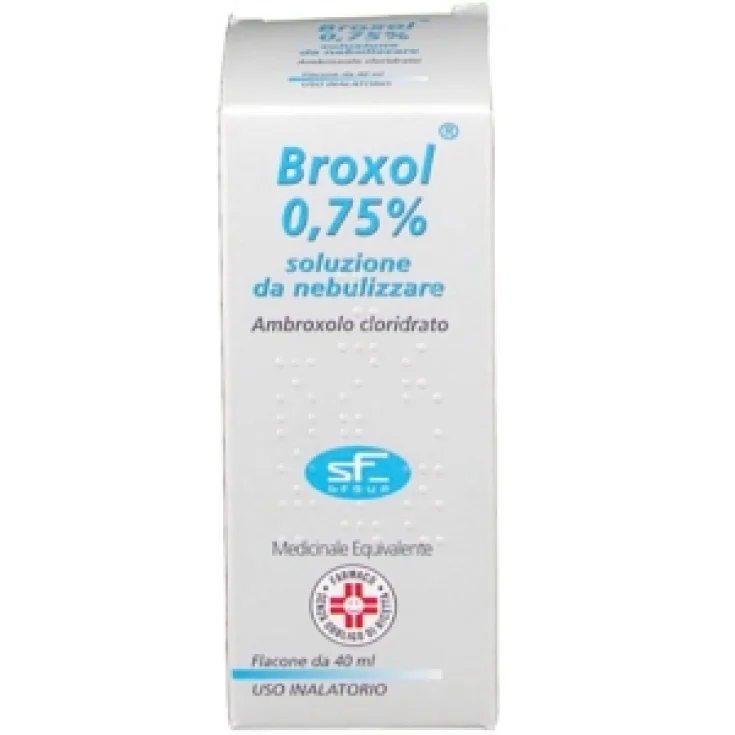SFGroup Broxol 0.75% Solution To Nebulize 40ml

- Brand: S.F. GROUP Srl
- Product Code: 025573104
- EAN:
- Availability: In 10 - 14 Days
- 3 items
for 12,25€ each - 4 items
for 12,00€ each - 5 items
for 11,75€ each
SFGroup
Broxol 0.75%
Solution to Nebulize
Broxol nebuliser solution can be used in various inhalation devices. It is miscible with physiological saline solutions and it is recommended to dilute it in equal parts (ratio 1: 1) to obtain an optimal humidification of the air emitted by the inhaler. Broxol nebuliser solution must not be mixed with chromoglycolic acid. Broxol nebuliser solution must not be mixed with other solutions whose resulting mixture has a pH greater than 6.3, such as alkaline nebulizer solutions (Emser salts). Precipitation of the free base of ambroxol hydrochloride or clouding of the solution may occur due to the increase in pH. General As inhalation itself may lead to coughing, it is recommended that you breathe normally when inhaling. It is recommended to warm the solution to body temperature before inhalation. In patients with bronchial asthma it is recommended to administer the usual bronchospasmolytic before inhalation. In acute respiratory conditions, seek medical attention if symptoms do not improve or worsen during treatment with Broxol.
Excipients
Citric acid monohydrate, disodium phosphate, sodium chloride, benzalkonium chloride, purified water.
Therapeutic indications
Treatment of secretion disorders in acute and chronic bronchopulmonary affections.
Contraindications
Hypersensitivity to the active substance or to any of the excipients. Severe hepatic and renal disorders. The drug is contraindicated in case of rare hereditary diseases that may be incompatible with one of the excipients (see section 4.4).
Dosage
Children up to 5 years: 1–2 ml of solution 1–2 times a day.
Adults and children over 5 years: 2–3 ml of solution 1–2 times a day.
Warnings and Precautions
Ambroxol hydrochloride should be administered with caution in patients with peptic ulcer. In very few cases, severe skin lesions such as Stevens Johnson syndrome and toxic epidermal necrolysis (NET) have been observed simultaneously with the administration of expectorants such as ambroxol hydrochloride. Most of these could be explained by the severity of underlying disease or other concomitant complications. Also in the early stage of Stevens Johnson syndrome or toxic epidermal necrolysis (NET), patients may initially experience non-specific flu-like symptoms, such as fever, chills, rhinitis, cold and sore throat. Due to these misleading symptoms it is possible that symptomatic treatment with cough and cold therapy may be undertaken. If new lesions of the skin or mucous membranes occur, consult your doctor immediately and precautionary discontinue treatment with ambroxol hydrochloride. In case of impaired kidney function, Broxol can only be used after consulting your doctor. Important information about some of the ingredients: Broxol contains benzalkonium chloride as a preservative. Upon inhalation, this preservative can cause bronchospasm in sensitive patients with hyperreactivity of the airways.
Interactions
Following the administration of ambroxol the concentrations of antibiotics (amoxicillin, cefuroxime, erythromycin) in bronchopulmonary secretions and saliva are increased. No interactions with other medicinal products have been reported.
Side effects
Adverse reactions are listed below by system organ class and by frequency according to the following categories: Very common (≥ 1/10), common (≥1 / 100 to <1/10), uncommon (≥1 / 1,000, <1/100), rare (≥1 / 10,000, <1 / 1,000), very rare (<1 / 10,000), not known (cannot be estimated from the available data). Immune system disorders Not known: anaphylactic reactions including anaphylactic shock, angioedema and other hypersensitivity reactions. Skin and subcutaneous tissue disorders Rare: rash and urticaria; not known: itching. Nervous system disorders Common: dysgeusia. Gastrointestinal disorders Common: nausea, oral hypoesthesia; uncommon: vomiting, diarrhea, dyspepsia, abdominal pain, dry mouth; not known: dry throat. Heartburn has also been reported. Respiratory, thoracic and mediastinal disorders: Common: pharyngeal hypoesthesia.
Pregnancy and breastfeeding
Ambroxol hydrochloride crosses the placental barrier. Animal studies have not shown any direct or indirect harmful effects on pregnancy, embryonic / fetal development, parturition or postnatal development. Although preclinical studies and extensive clinical experience have not shown any harmful effects after the 28th week of gestation, it is recommended that normal precautions be taken when taking medications during pregnancy. Especially during the first trimester it is not recommended to take Broxol. Ambroxol hydrochloride is excreted in breast milk. Although no adverse effects are expected in breastfed infants, the use of Broxol is not recommended during breastfeeding
Format
40ml bottle






